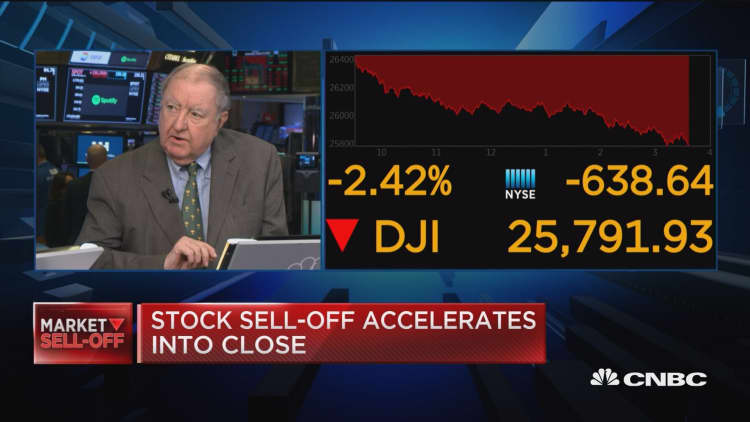
The market sell-off is partially seasonal, and partially a case of weakness driving further weakness, Wall Street veteran Art Cashin told CNBC on Wednesday.
"The first two weeks of October are historically biased to the downside — they are usually cleaning up a sell-off from September. We didn't get much of one this year, but we are still in that negative two-week period," Cashin said on Closing Bell."
"I think what you saw was a test and a failure ... and I think that prompted a lot of people to say, 'Oh my goodness, this is not what we're used to.' Support is supposed to hold and [stocks] are supposed to bounce. So the failure to bounce brought in additional selling," said Cashin, UBS director of floor operations at the New York Stock Exchange.
The Dow Jones Industrial Average closed down 831.83 points at 25,598.74, near its lows of the day, as Intel and Microsoft fell more than 3.5 percent each. The Nasdaq composite plummeted 4 percent to 7,422.05.
The dropped 3.3 percent to 2,785.68, with the tech sector underperforming. The broad index also posted a five-day losing streak — its longest since November 2016 — and fell below its 50-day and 100-day moving averages, widely followed technical levels.
"We saw the market go down and test various moving averages, various trend levels — and they tested successfully and bounced a little bit. Today they went down to those testing areas and failed," Cashin said. "The selling brought in a bit of a domino effect, where the weakness led to further weakness. And I think that is why you're down 600 and some odd points, too."
Cashin said the drop is 80 percent technical. He attributed the other 20 percent of the sell-off to "foreign things," like currencies and trade war fears. Cashin said he will be watching foreign markets to see if selling continues into Thursday.
Scott Minerd, Guggenheim's global chief investment officer and chairman of investments, predicts there will be a bottom sometime before the end of the month, saying Wednesday on CNBC's "Power Lunch" that the recent market action is less a harbinger of a crash than a standard seasonal sell-off. He said, "It's too soon to call the end of the bull market."
Cashin agreed and longer term, he expects things to stabilize.
"I do think it's a bit of a calendar item and when we get past these first few weeks [of October], things may slow down a little," he said.
Cashin began his career at Thomson McKinnon in 1959. In 1964, at age 23, he became a member of the NYSE and a partner in P.R. Herzig & Co.
— CNBC's Fred Imbert contributed reporting.


